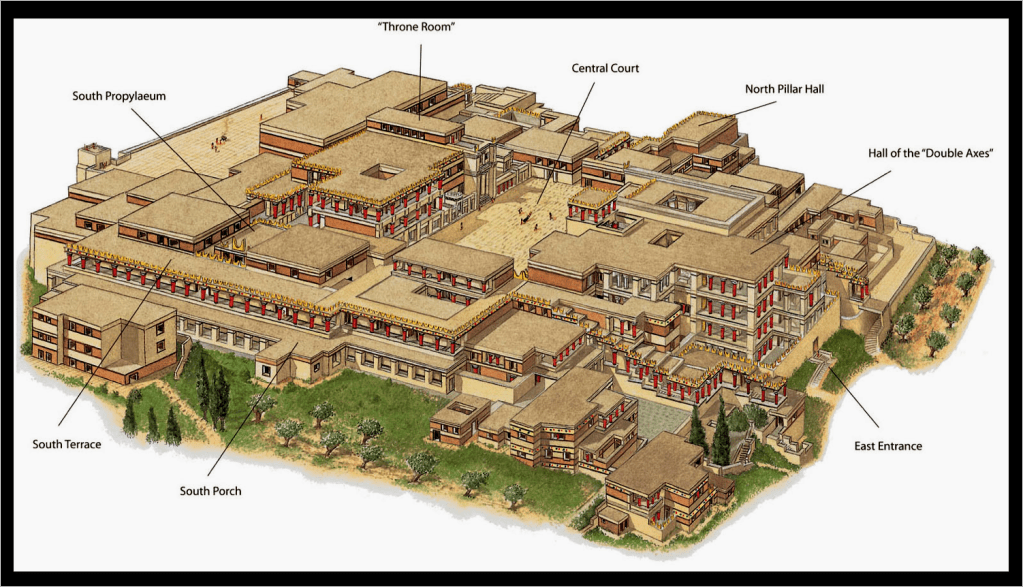The Phaistos Disc. I was surprised to learn about this artifact (a picture is below). It was found on the island of Crete, where the Minoan civilization flourished. The Minoans are often thought of as the ancestors of the Ancient Greeks, and are perhaps most famous for the story of the Labyrinth and the Minotaur. They provided the Greeks with important cultural elements, such as their first form of writing, Linear A (still undeciphered) and with most of the Gods that the Greeks worshiped.

As we know, the great empires and civilizing forces first existed in the Middle East and in North Africa during Antiquity, and the emergence of Europe’s dominant cultures and civilizations was influenced by the outpouring of Eastern cultures into the coastlines of the Mediterranean. In this way, at the time of the Minoans, (approximately 3000B.C. until 1100B.C.), they were among the furthest outpost of Eastern civilization in the Mediterranean Sea.
The Minoans appear to have been primarily influenced by Ancient Egypt. Many of their gods are hybrids or copies of Egyptian Gods, and even their writing, Linear A, evolved from Egyptian Hieroglyphs. It is worth noting that the origins of the alphabet that I am using to communicate with you was Egyptian Hieroglyphs, which was an original form of writing; it has no ancestor. Over a long period of time the Egyptian system of writing evolved into the Latin Script that we use, via ancient Greek. An important moment in this process was when glyphs transformed into an alphabet. The Egyptian Hieroglyphs are not phonetic soundbites, as our letters are: they are logograms, which means that the symbols represent entire words or ideas. This brings us back to the topic of our artifact.

I thought that by the time writing had arrived on European soil, it had fully shaken off it’s hieroglyphic past. The Phaistos Disc might prove otherwise. It shows a clay disc, with both sides stamped with hieroglyphs. This disc cannot properly be dated, but it fits in with a collection of other items found that bear similar (but not identical) symbols. These hieroglyphs are known as Minoan Hieroglyphs, which suggests that they represent words that would have been used by the Minoans, however, it is important to note we don’t know who made them, nor do we know what language they are from.
In reality, we don’t really know anything about this disc, only that it was found in 1908 in a Minoan Palace. It is a true mystery. In fact, there is even debate as to whether this disc shows the same symbols as the other items I mentioned. It could be that the symbols on the Phaistos Disc are from another catalogue of hieroglyphs, and relate to another language. Arthur Evans, an important archaeologist that contributed to the excavations on Crete, said that ”when one comes to compare the figures in detail with those of the Minoan hieroglyphic signary, very great discrepancy is observable […] Out of the forty-five separate signs on the Phaistos Disk, no more than ten more or less resemble Cretan hieroglyphic forms. […] The human figures in their outline and costume are non-Minoan. […] The representation of the ship also differs from all similar designs that occur either among the hieroglyphic or the linear documents of Crete.”
Who made the Phaistos Disc, where did it come from, why did it end up in Crete, what is it trying to tell us? These hieroglyphs, and the people who created them, are another mystery buried by the Bronze Age Collapse. Time will tell if they will ever yield their secrets. https://en.m.wikipedia.org/wiki/Phaistos_Disc
There are some wild and wonderful theories about the disc and its origins. I especially like the attempts at ‘decipherment’ which make for entertaining reading…
LikeLike
I’ll have to give those a look haha!
LikeLiked by 1 person
Great post!! The Minoans are overlooked so often, but I think they had a really interesting civilization surrounded by so much mystery (which always makes history more interesting, in my opinion).
LikeLiked by 1 person
Thanks Laura, I definitely agree about the mystery!
LikeLike